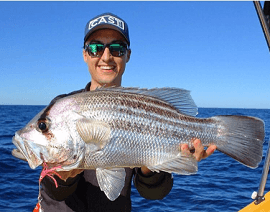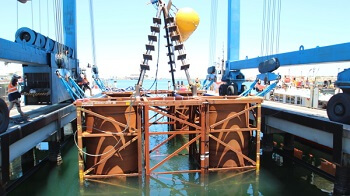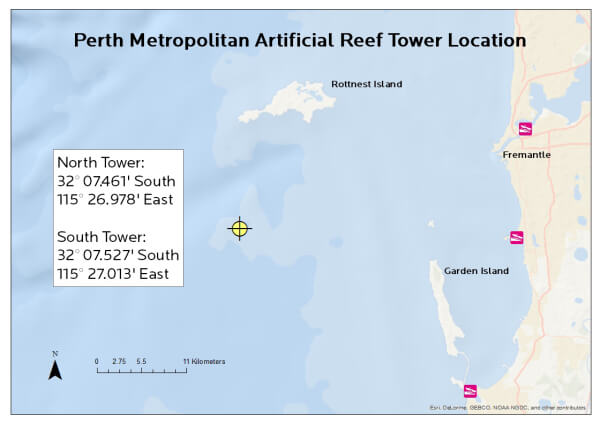A vast network of artificial reefs is rapidly expanding around WA’s coastline creating additional places to fish and more fish to catch. Continue reading “Recfishwest’s Rottnest fish towers fire up”
Tag: fish towers
Fish Towers to be deployed this summer
Get ready for some metro pelagic fishing this Summer at the new Fish Towers! Two new exciting Fish Towers will be deployed this summer in the metropolitan region, funded through recreational fishing licence fees, creating exciting brand new fishing opportunities. The Fish Towers add to the continued development of artificial reefs in WA, joining the highly successful artificial reefs off the coasts of Dunsborough, Bunbury and Mandurah. The towers will be the first steel artificial reefs deployed in WA, with a different layout and construction material, on a much larger scale than the artificial reefs further south.
 Designed by Western Australian artificial reef specialists, Subcon, the purpose built reefs are an impressive 12.5m high or the same size as a four storey building! To add to its height, each reef weighs a massive 50 tonne and is 10m long and 7.8m wide. The costly process of reef deployment at sea has also been reduced through a new innovative technique that has never been used with this style of artificial reef anywhere in the world. Instead of being loaded onto a barge and deployed using a crane, the large structure will be towed out into position and its buoyancy tanks will be flooded to safely and cost effectively sink the towers.
Designed by Western Australian artificial reef specialists, Subcon, the purpose built reefs are an impressive 12.5m high or the same size as a four storey building! To add to its height, each reef weighs a massive 50 tonne and is 10m long and 7.8m wide. The costly process of reef deployment at sea has also been reduced through a new innovative technique that has never been used with this style of artificial reef anywhere in the world. Instead of being loaded onto a barge and deployed using a crane, the large structure will be towed out into position and its buoyancy tanks will be flooded to safely and cost effectively sink the towers.
The fish towers have been specially designed for both pelagic and demersal fish species. The lattice-like steel upper part of the reef will concentrate small baitfish such as Yellowtail Scad, Bullseye, Pike and small Trevally, making the reef a perfect location for predatory pelagics. As well as this, the large area, vertical profile and differing types and shapes of the bottom part of the structure make it an ideal home for demersal species. The reasons that the towers make such a perfect homes for these fish species comes from their purpose built design.
The steel lattice provides shelter for baitfish from pelagic predators (which attracts these predators to the tower) while the structures’ complex habitat provides variation in temperature, shade and hydrological effects such as current, to favour a variety of different species and higher abundances of fish. The curved steel plates on the fish tower promote upwelling and the surfaces of the structure can be colonised by macro-algae, sponges and corals, both of these factors provide a boost to the food chain and increase the productivity of the reef, further increasing the number and variety of target species.
Pelagic species such as Samson Fish, Yellowtail Kingfish, Salmon, Spanish Mackerel and Tuna species could all be expected at the reef as well as demersal species such as Pink Snapper, Dhufish and Baldchin Groper. Other species that could be caught in the area around the reef include, King George Whiting, Flathead, Flounder and even Mulloway! While all the mentioned species are expected on the reefs (and have been observed on the artificial reefs further south) other fish may also turn up in the proposed deployment area including Yellowfin Tuna, Amberjack and Bonito.
The reefs were funded using recreational fishing licence fees and are there for all fishers to enjoy. Anchoring right on top of reefs should be avoided as it will limit the benefit they can have to all fishers and limit the chances of your anchor returning. As is the case with the South West Artificial Reefs, some of the best fish are caught around the structure, not right on top of it. Fish can be targeted by trolling around the area and over the top of the reef as well as drifting near the reef location or by drifting weighted mulies in a burley trail.
The exact locations are yet to be confirmed, but will be announced by Recfishwest in due course. It is expected they will be located between Rottnest and Garden islands and installation of the structures will begin this summer. With huge projects like this, WA is showing the world what can be achieved by passionate fishers who believe in enjoyable, safe, sustainable and accessible fishing experiences for the WA community in the future.
Pelagic Paradise Deployed Off Perth
In the October 2016 edition of Recfishwest’s Broad Cast we shared an article on the reef towers set to be installed off the Perth coast this summer. Well the news is good and the deployment is running ahead of schedule with one of the towers being installed on December 21, with the second set to be deployed late December.
Fishing for Perth metro pelagics is set for a breath of new life with the instalment of two steel reef towers, which will boost fishing opportunities for fishers over the summer months. The towers will be an addition to the numerous other artificial reef and habitat enhancement projects complete or underway in WA, funded through recreational fishing licence fees.
The reef towers differ from the concrete reef frameworks currently installed off Dunsborough, Bunbury and Mandurah and those planned for deployment in Esperance, Exmouth and Dampier. The towers are the first steel artificial reef structures, with a different layout and construction to the demersal reefs, and on a much larger vertical scale. Designed by Western Australian artificial reef specialists, Subcon, the purpose built reefs are an impressive 12.5m high or the same size as a four storey building!
 To add to its height, each reef weighs a massive 70 tonne and is 10m long and 7.8m wide. The costly process of reef deployment at sea has also been reduced through a new innovative technique that has never been used with this style of artificial reef anywhere in the world. Instead of being loaded onto a barge and lowered using a crane, the large structure is being towed out into position and its buoyancy tanks will be flooded to safely and cost effectively sink the towers.
To add to its height, each reef weighs a massive 70 tonne and is 10m long and 7.8m wide. The costly process of reef deployment at sea has also been reduced through a new innovative technique that has never been used with this style of artificial reef anywhere in the world. Instead of being loaded onto a barge and lowered using a crane, the large structure is being towed out into position and its buoyancy tanks will be flooded to safely and cost effectively sink the towers.
The reef towers have been specifically designed to not only house demersal fish species but namely to attract an array of pelagic top-water fish in a similar way to FADs. The lattice-like steel upper part of the reef will provide structure and concentrate small baitfish, attracting predatory pelagics. The purpose built design will also allow demersal species to shelter amongst the large base structure with its various shapes, crevasses and vertical profile.
The steel lattice structure provides a complex habitat with variations in temperature, shade and hydrological effects such as current. The curved steel plates on the tower promote upwelling and the surfaces of the structure can be colonised by macro-algae, sponges and corals to favour a variety of different species and higher abundances of fish.
The wide range of habitats influenced by the reef towers will hold a good variety of fish species, with pelagics such as Samson Fish, Yellowtail Kingfish, Salmon, Spanish Mackerel and Tuna all expected to turn up at the reef as well as demersal species such as Pink Snapper, Dhufish and Baldchin Groper. There’s also a good chance of King George Whiting, Skippy, Flathead, Flounder and even Mulloway that are caught in the surrounding areas. All of these species have been encountered on the established South West artificial reefs but other species such as Yellowfin Tuna and Bonito are also expected to make an appearance.
The reef towers were funded using recreational fishing licence fees and are for all recreational fishers to enjoy. Anchoring right on top of reefs should be avoided as it will limit the benefit they can have to all fishers and the chances of your anchor returning. Similar to the South West artificial reefs, some of the best fish are caught around the structure, not right on top of it. Fish can be targeted by casting or trolling around the area and over the top of the reef as well as drifting near the reef location and jigging or drifting weighed baits in a burley trail.
The reef towers will be located in “the paddock” between Garden Island and Rottnest Island, see map below for coordinates. With huge projects like this, WA is showing the world what can be achieved by passionate fishers who believe in enjoyable, safe, sustainable and accessible fishing experiences for the WA community in the future.
 This project was made possible by the Recreational Fishing Initiatives Fund and supported by Recfishwest and the WA Department of Fisheries.
This project was made possible by the Recreational Fishing Initiatives Fund and supported by Recfishwest and the WA Department of Fisheries.